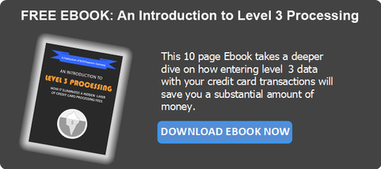Depending on the business, credit card transactions will fall under three different categories: Level 1, Level 2, and Level 3 processing. A business processing cards will either fit into one or all of the levels of processing depending on the type of business and what type of customers the business primarily deals with. Knowing these levels will result in a greater understanding of how rates apply and ultimately save a business money.
While each level has different processing rates, a good rule of thumb is the more data you receive from your client, the less the processing fee will be. In other words, the more data you have, the less of a risk of fraud there is, which results in a less expensive processing rate.
Level 1 Processing
Level 1 processing usually refers to business-to-consumer (B2C) processing. This might be a  convenience store, a restaurant, or any other enterprise where the business is selling their product or service directly to the consumer. Level 1 processing requires the least amount of data from the consumer, usually just their name, the amount of the transaction, and the date the transaction was made.
convenience store, a restaurant, or any other enterprise where the business is selling their product or service directly to the consumer. Level 1 processing requires the least amount of data from the consumer, usually just their name, the amount of the transaction, and the date the transaction was made.
If a business is conducting business-to-business transactions (B2B) they will almost always fall under Level 2 or 3 processing.
Level 2 Processing
Level 2 processing is the starting point for most business-to-business transactions. Depending on how much information a company requires from their clients, they might stay in Level 2 or move up to Level 3. Level 2 processing has to meet all the criteria of Level 1 processing but also has to include criteria like tax information, a customer code if applicable, and the merchant postal code.
Not only does Level 2 processing decrease the risk of fraud, it also may enhance the customer experience and customer service by providing your client detailed transaction information. Since building a strong relationship with your clientele is essential for any business, Level 2 & 3 is a great catalyst for maintaining that relationship.
Level 3 Processing
When doing B2B or B2G transactions you’ll notice Level 3 processing has to include all the data requirements from Level 2 processing in addition to several other criteria such as product codes, freight information like duty, postal codes from both the products destination as well as origin, any discounts that may apply, the country code, tax information, and more.
The more information entered, the risk of fraud is significantly less and therefore processing rates may be lower than the other two levels. Level 3 processing also requires advanced processing software to keep track of all the data that is required. If your business has a government contract that requires Level 3 processing, make sure you sign with a Merchant Service Provider that is able to give you the tools necessary to process Level 3 transactions.
There are Merchant Service Providers that specialize in Level 3 processing and it would be a good idea to seek that out instead of going with one that just has lower rates. When it comes to Level 3 data, it’s always a better idea to be safe than sorry, as being non-compliant may result in losing your client or getting your business into serious jeopardy.

